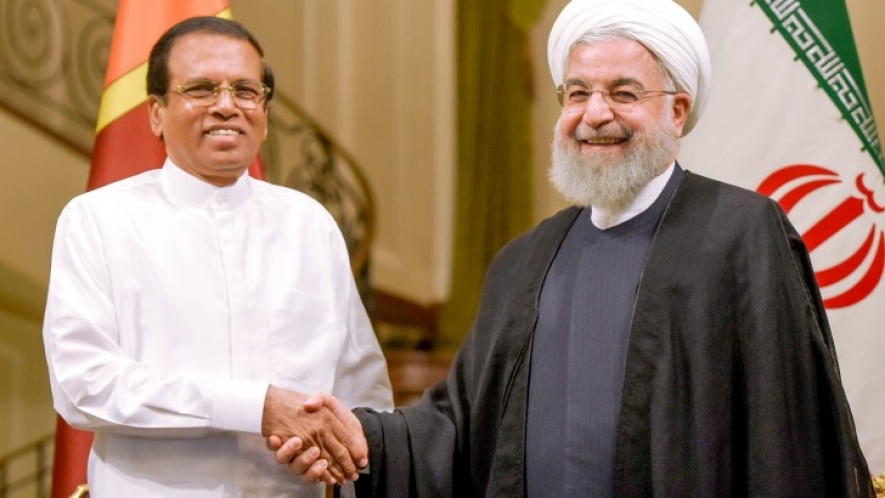The main thrust of President Sirisena’s middle path foreign policy is, ‘friendship with all’. Sri Lanka and Iran are members of the Non Aligned Movement as well as the Asian Cooperation Council. Although, some so-called foreign affairs Pundits stated that the timing of the visit was wrong because of President Donald Trump’s decision to withdraw from the Iran nuclear deal just 3 days before the visit of the Sri Lankan President, there was absolutely no connection between the two issues.
It is surprising that these foreign policy analysts were not aware that the Visit of President Sirisena was originally scheduled to take place in 2016. After fixing the dates twice in 2016 and 2017, it was postponed for the third time due to unavoidable circumstances – these were not of political or strategic nature, but purely due to the heavy schedules of the leaders of Iran and Sri Lanka.
Sri Lanka maintains excellent relations with the United States and Europe in addition to India, Russia, Japan, South Korea and Pakistan. However, under the broad policy of non-alignment and friendship with all the countries, President Sirisena visited Qatar and South Korea last year and Iran this year.
If any foreign embassy is irked at the visit to Iran last week, it is due to the failure of the foreign office to brief the foreign missions in Colombo on the background of the visit and about the long-standing invitation from Iran. Such briefings are routinely done to dispel possible misunderstandings as that should not be interpreted as a show of subservience.
Qatar appreciated President Sirisena’s bold decision to visit Doha at a time when that country has been diplomatically isolated by its Arab neighbours and US over accusations that it is funding terrorism in the region.
The decision taken by the President to visit must have been prompted by the fact that Qatar’s Emir was the only West Asian Head of State to have visited Sri Lanka in recent years.
President Sirisena keeps foreign policy analysts guessing all the time. Many analysts came up with their textbook prediction that he had antagonized United States and its Middle East friends like Saudi Arabia, when he paid a state visit to Qatar. Before the dust of criticism settled down, President Sirisena undertook another state visit – this time to South Korea and the so-called foreign policy experts were totally baffled as they were not sure whether the visit should be described as a pro-US gesture or not.
The two salient features of the foreign policy of the current government are, firstly it is Asia-centric middle path and secondly friendship with all. As foreign policy of any country puts the country’s interest first, Sri Lanka too cannot be rigid in its policy towards the international community.
Visits to Qatar and South Korea were very beneficial to Sri Lanka. In addition to investing in an LNG plant, Qatar also agreed to supply the LNG on a long term basis under an agreement to be reached later between the two countries. The initial MoU on cooperation in the field of energy was signed by the Minister of Power and Industries of the State of Qatar, Mohamed Bin Salih Al Sada and the then Deputy Minister of Power and Renewable Energy Ajith P. Perera in the presence of the Emir of Qatar and President Sirisena in Doha.
The South Korean President, breaking protocol, arrived at the famous Buddhist temple in Seoul to receive President Sirisena, a day prior to the official meeting to show his high regards for the Sri Lankan leader.
There is absolutely no need for USA, Europe, China or India to worry about President Sirisena’s visits to countries they perceive as hostile, because those visits are very much in line with Sri Lanka’s middle path foreign policy.
Last week, Iran accorded a grand welcome to President Sirisena and all the newspapers carried the story of the meeting of the two Presidents as the lead story with large front-page photographs.
The five MoUs were signed in the presence of Iranian President Rouhani and President Sirisena. The agreements include four mutual cooperation deals as well as a program on cultural exchanges. The cooperation documents include an agreement on fighting narcotics and psychoactive drugs, an agreement on health, medical sciences, medicines and medical equipment, and agreement between the Iranian Standardization and Industrial Research Institute and the Sri Lankan Standardization Institute on standardization, measurement, training, laboratory services and issuing certificates. The two sides also signed an agreement on the film industry, and a cultural deal on cultural and scientific exchanges between the two sides.
During the meeting, President Rouhani said, Iranian companies are ready to provide technical-engineering services to Sri Lanka. President Rouhani described relations between Iran and Sri Lanka developing in all fields, stressing that the two countries have reached good agreements in the economic fields of mutual interest to both, and said, ‘Relations between the two great Iranian and Sri Lankan nations go back to centuries.’
‘Iran and Sri Lanka have had close political relations with each other for tens of years,’ he continued, adding, ‘In today’s meetings, we discussed various issues such as selling oil, petrochemicals, construction materials and technical-engineering services.’
‘I hope that in the 12th Joint Economic Commission of the two countries, which is going to be held in Tehran soon, all issues in economic, trade and technical-engineering services will be followed up.
Considering ample tourist attractions of Iran and Sri Lanka, issues of tourism and direct flights between Tehran and Colombo were also discussed to facilitate travel between the two countries.
Fortunately, Iran and Sri Lanka have close views on regional and international issues, and I hope the constructive interactions of the two countries in international organizations, including in the Non-Aligned Movement and Asian conventions will continue as before,’ President Rouhani said.
Courtesy - Sugeeswara Senadhira




















